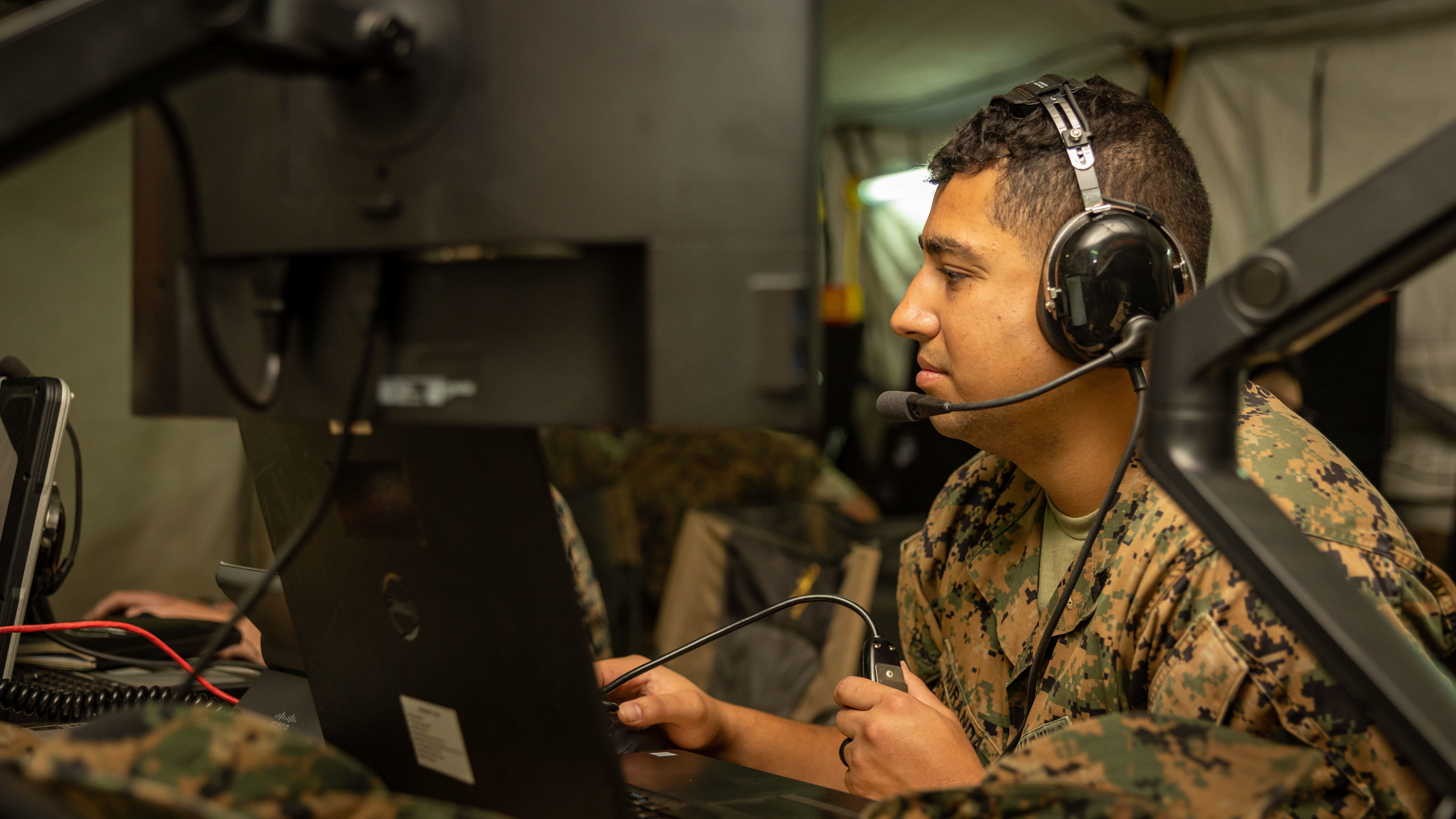
SAN DIEGO – The success of small Marine Corps units dispersed across far-flung islands in contested terrain will need a better integrated joint operating picture.
A demonstration held in Hawaii last week provided a glimpse of what some existing capabilities can give Mairnes and offered an opening for new or existing technologies to fill gaps and further refine the concepts for command and control in the distributed maritime battle space, service officials said this week at the West 2023 conference hosted by the U.S. Naval Institute and AFCEA.
To explore the idea for future Expeditionary Advanced Base Operations, the California-based I Marine Expeditionary Force did the experiment based on a “hub, spoke and node” framework. The emerging construct is a focus of recent efforts by the San Diego-based 3rd Marine Aircraft Wing during its “Fury” series of training exercises.
In Hawaii, personnel with Marine Air Control Group 38, I Marine Expeditionary Force and I MEF Information Group, based at Camp Pendleton, Calif., set up an expeditionary command-and-control node with their gear and equipment organic to 3rd Marine Littoral Regiment, which is part of Japan-based III Marine Expeditionary Force. Working with Marines with Camp Lejeune, N.C.-based II MEF, they established a Multi-Domain Operations Center and a Multi-Function Air Operations Center on a football field at U.S. Pacific Command headquarters at Camp H.M. Smith.
Meanwhile, in Japan, officials said, III MEF units formed an All-Domain Operations Center that provided the higher echelon, task force-level C2 node for the week-long exercise that culminated in a Feb. 7 demonstration for U.S. Pacific Command and Marine Corps Forces Pacific. The demonstration, done in a scenario representative of existing regional threats from China, was done at the request of Adm. John Aquilino, the PACOM commander, and coincided with the PACOM regional commanders’ conference.
“For seven days, we conducted real-world, constructive operations inside the First Island Chain,” Col. Jeremy Winters, who commands MACG-38, 3rd Marine Aircraft Wing, based at Miramar Marine Corps Air Station in San Diego, told an audience at a panel discussion on multi-domain operations and expeditionary kill webs.
The combined and joint forces did it with “real airplanes, real submarines, real surface action combatants operating under First Island Chain under an all-domain command-and-control architecture that’s designed to fight, tonight,” Winters said. “Pretty impressive.”
In the future fight, officials expect to deploy newer capabilities, like the tactical aviation ground refueling system or TAGRS, that can hot refuel two advanced F-35B Lightning II Joint Strike Fighters in under 30 minutes, or the light Marine air defense integrated system, or LMADIS, that can neutralize unmanned air drones. As envisioned, the hub, spoke and node model can fuse tactical information links and enable a joint common operating picture, one that “frankly can work with any maneuver force – Marines, submarines, U.S. Air Force and surface action groups,” Winters said.
For small, mobile, dispersed units, it improves combat capabilities for deployed units down range where risks from the enemy and from far-off combat support are greatest. The MEF, then, can conduct missions like raids, for example, across a wider battle space while still having the required support.
“Where a ground combat element seizes terrain and holds it for us,” he said. “We pop up this episodic and temporal node that delivers real logistics and data to the kill web architecture, and we’re out of there because somebody else is trying to target us.”
Panel members made a pitch to industry representatives attending WEST to help the Marine Corps expand expeditionary kill webs.
Winters spoke of the need for an integrated framework, “a system – one system – with digital encryption that allows me to do that.”
“I need a platform-agnostic, encryption capability both on my end-user devices and for my transport,” he said, adding he wants “one token where I can stick it in a computer and it can gives me any network that I need access… That’s the encryption that I really need.”
Moreover, “it needs to be one integrated framework” at the tactical edge for those “who really close kill chains,” he added.
To provide reliable communications, along with securing deployed networks and the tactical grid, “the ability to move from one to the other, as they start to close down, is absolutely critical to resilient comms and [command and control] in general,” said Col. Kevin Root, commander of I MEF Information Group at Camp Pendleton.
With the pacing threat from China, and the continuing Russia-Ukraine war unsettling adversaries in that region, tech advances cannot come fast enough. “Four years ago, we felt like we had time,” Col. James Lively, I Marine Expeditionary Force assistant chief of staff, told USNI News after the panel.
Lively recounted to the audience the story – contained in a recent report by the Center for Strategic Budgetary Assessment, “Innovating for Great Power Competition” – of then-Rear Adm. Jerry Tuttle, a battle group commander and advocate of using existing commercial technologies and who, in 1981, was the first to use a commercial off-the-shelf computer on a ship. Tuttle’s action, he noted, “started driving the Navy” toward Joint Operational Tactical System.
nine years to go to scale,” Lively said. “There was a choice to take a [commercial] thing, put it on a carrier… I’m sure there was a lot of red tape to cut through. I think the growing concern is we don’t have nine years.”
“How do we pick winners faster and put equipment in the hands of warfighters?” he said. “That’s our challenge at hand, for sure.”





